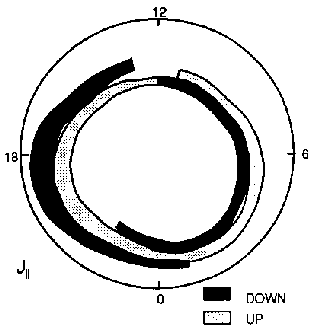 Field-aligned currents (FAC)
Field-aligned currents (FAC)
spaceweb@oulu.fi - last update: 24 November 1998, 1555 UT (RR)
Field-aligned currents (FAC, also called the Birkeland currents) are
essential to the
linkage
between the
solar wind -
magnetosphere
system and the
ionosphere.
The main large scale FAC systems are the Region 1 and 2 currents.

Region 1 currents
- Inner ring driving the R1/R2 system
- Directed into the ionosphere in the morning hemisphere
- Directed out of the ionosphere in the evening hemisphere
- Expands to lower latitudes with increasing activity (see also the
auroral ovals)
- Gets weaker during weak activity (northward
IMF, i.e., NBZ)
- Maximises between 0800 and 1000 MLT in the morning side and
between 1400 and 1600 MLT in the afternoon side
- Current increase as the electric field associated with the
solar wind/IMF increases (but is non-zero even during zero
electric field, just like the
polar cap
potential difference)
Region 2 currents
- Outer ring following the R1 system
- Current directions opposite to the Region 1 system
- Respons to the activity level as Region 1 current ring
Mantle/NBZ currents
- Poleward of the R1 near local noon (see cusp)
- Current directions opposite to the adjacent R1 currents
- Strong IMF By effect: for By > 0 predominantly upward in the
norther hemisphere and downward in the southern, and the
other way round for By < 0
- Strong IMF Bz effect
- Bz < 0: mantle (previously called the cusp) currents (see
Lin and Lee, 1994)
- Well localized, weak currents
- Bz > 0: NBZ currents
- Expand and become as strong as the weakened R1/R2 currents
Special FAC types
References
- Lin, Y. and L. C. Lee, Generation of Region 1 and mantle
field-aligned currents by the secondary rotational discontinuity,
in Solar Wind Sources of Magnetospheric
Ultra-Low-Frequency Waves, Geophysical Monograph 81,
213-221, 1994.
- Yamamoto, T., S. Inoue, N. Nishitani, M. Ozaki, and C.-I. Meng,
A theory for generation of the paired region 1 and region 2 field-aligned currents,
J. Geophys. Res., 101, 27199-27222, 1996.
See also:
 Field-aligned currents (FAC)
Field-aligned currents (FAC) Field-aligned currents (FAC)
Field-aligned currents (FAC)